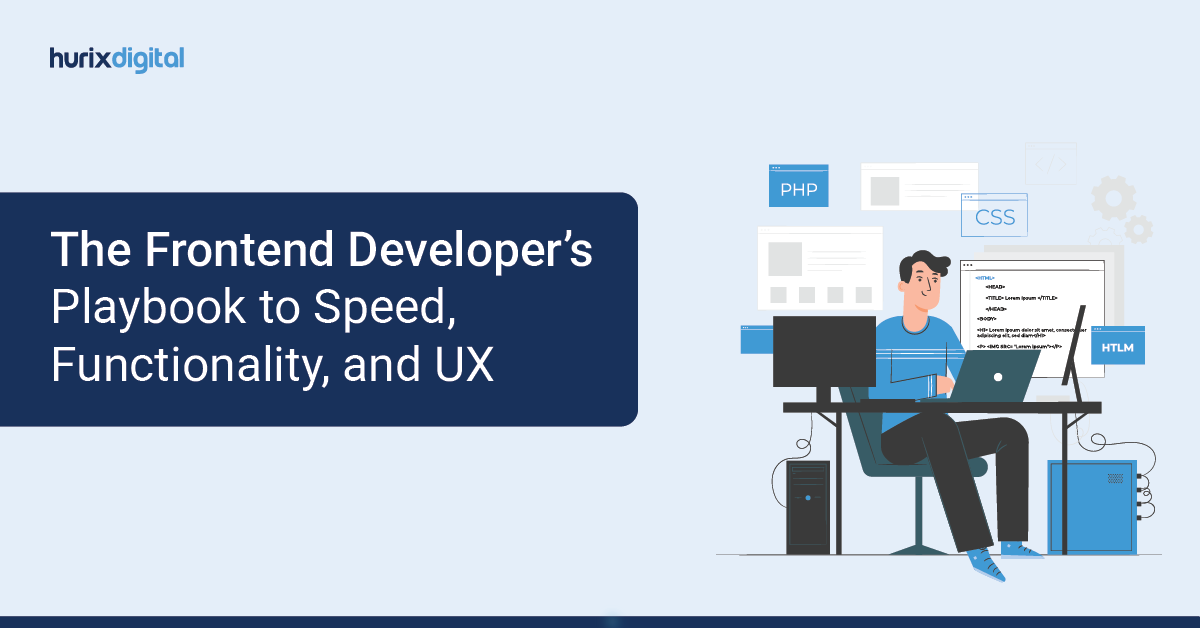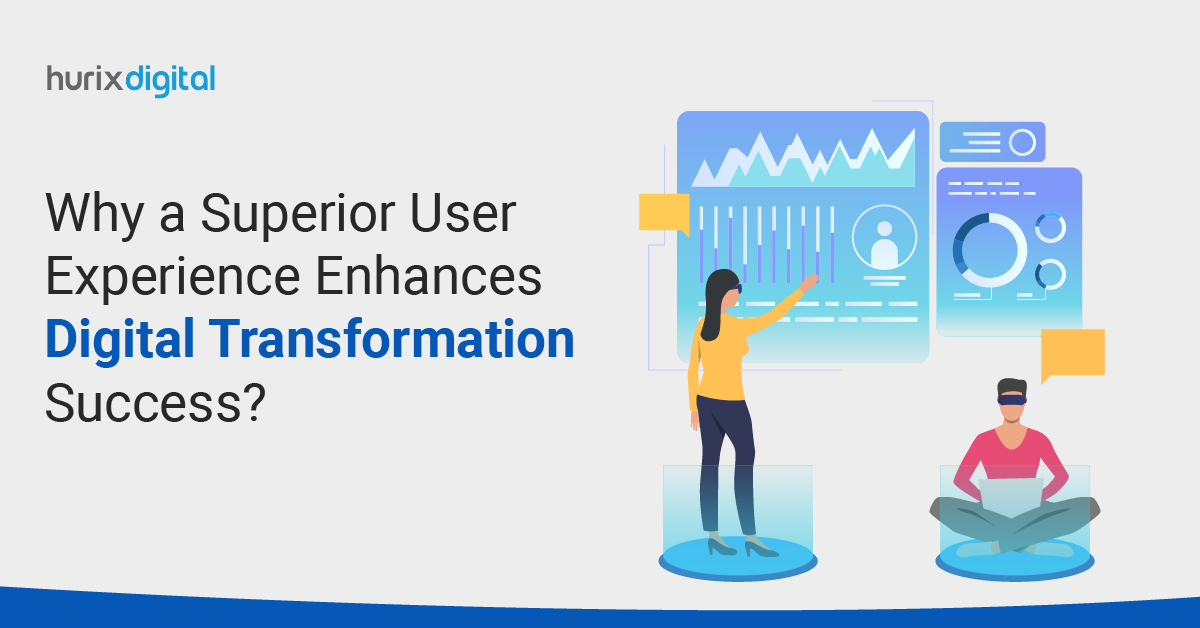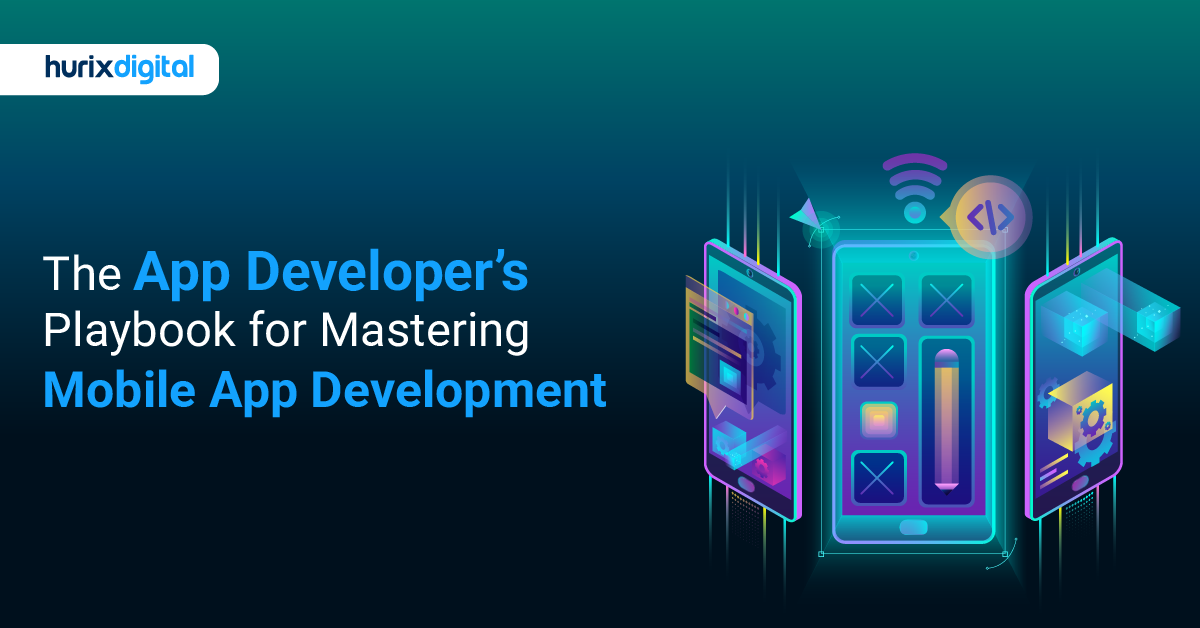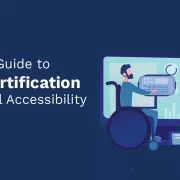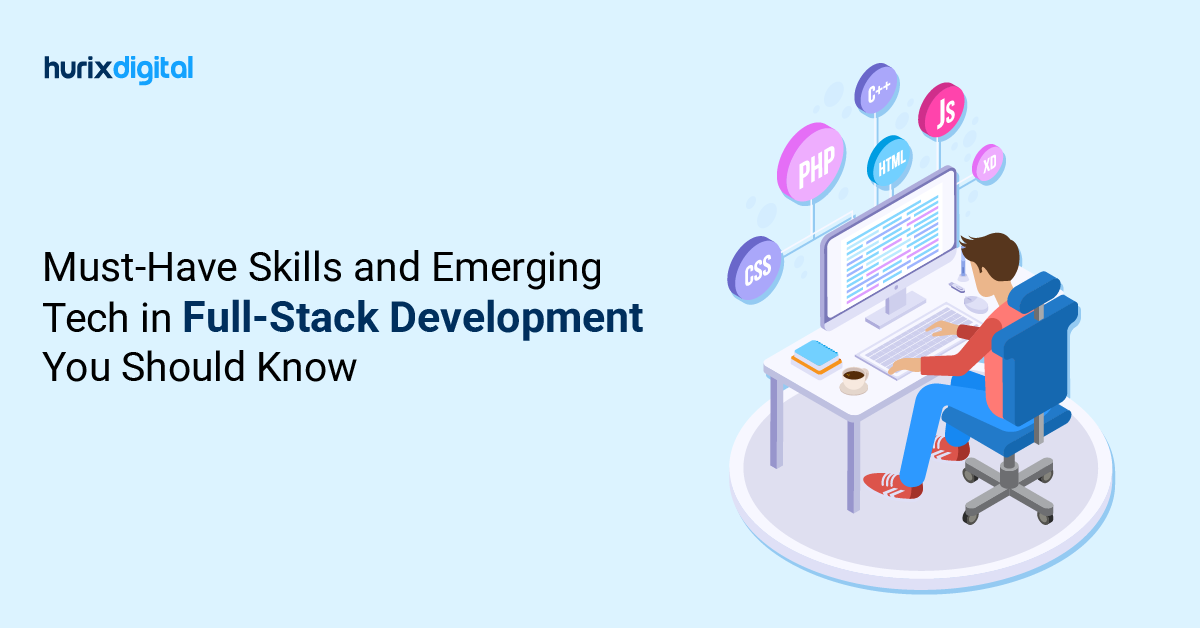
Must-Have Skills and Emerging Tech in Full-Stack Development You Should Know!
As the digital world expands, businesses increasingly rely on online platforms and virtual interactions to thrive. This growing trend fuels the demand for full-stack web developers who can handle all aspects of web development.
The market for web development is predicted to grow at a compound annual growth rate (CAGR) of 8.03% throughout the forecast period, from its valuation of USD 56 billion in 2021 to USD 89 billion by 2027. Because of this, every full-stack web developer must be prepared to meet the demands of the digital age.
If you’re a business owner looking for full-stack app development, this blog is for you. We list down future trends you must consider to stay ahead of the game and maximize your business growth.
Table of Contents:
- What is Full Stack Development?
- 5 Must-Have Skills for a Full Stack Web Developer’s Success
- Top 5 Tips and Best Practices to Maximize Efficiency as Full-Stack Developers
- 6 Benefits of Hiring a Full Stack Development Company
- When Should You Hire Full Stack Development Services?
- Current Scenario of Full Stack Development
- Conclusion
What is Full Stack Development?
Before we move ahead with the future trend analysis of full-stack development, let’s understand quickly what it is and where full-stack app development stands today.
Full-stack development means being able to handle both the front-end and back-end parts of creating an app or a website. So, a full-stack developer knows how to design what users see and interact with (like buttons and menus) on the front end and the behind-the-scenes aspects (like databases and servers) on the back end.
Full-stack developers possess a diverse skill set that allows them to handle both front-end and back-end development tasks. They are proficient in languages and frameworks such as HTML, CSS, and JavaScript (for front-end). They’re also well-versed in server-side languages like Node.js and Python and databases like SQL.

5 Must-Have Skills for a Full Stack Web Developer’s Success
With this vast and vital set of responsibilities, specific skills are crucial to thrive in the industry and successfully deliver quality work.
Here are five must-have skills for every full-stack web developer!
1. UI and UX Design Proficiency
User Interfaces (UI) and User Experience (UX) are the first things customers and users encounter, so it is crucial to be proficient in them.
To be adept with UI design, here are the key aspects every full-stack developer must focus on:
- Visual design concepts help create appealing interfaces that align with the brand’s identity.
- Graphic design tools enable developers to generate high-fidelity prototypes and more interactive elements.
- Cross-platform and multi-device compatibility aspects, especially those adopting a mobile-first development approach, enable more user accessibility.
To control the narrative of UX design, focus on increasing the foundational hold of these skills:
- User research skills, such as behavioral user trends and target demographic preferences, help integrate customer needs to deliver a more seamless experience.
- Understanding information architecture helps establish clear, logical paths and hierarchies.
2. Robust Front-End Development Coding
Hand-in-hand with understanding what makes a comprehensive UI and UX experience comes the process of creating and implementing it. That is precisely what front-end development is about for a full-stack web developer.
As front-end skills are mainly based on coding and digital language proficiency, here are the most vital and popular languages that full-stack developers must focus on:
- HTML (Hypertext Markup Language): HTML is used to structure the content of web pages and create the foundation of a website.
- CSS (Cascading Style Sheets): CSS can leverage and control the layout, colors, typography, and other visual aspects, ensuring a visually appealing and consistent design.
- JavaScript (JS): Over 63% of programmers worldwide use JavaScript. It facilitates interactive and dynamic features on a website, like form validations, image sliders, and dynamic content updates, all without a page reload.
- Front-end Frameworks and Libraries: Popular front-end frameworks include React.js, Angular, and Vue.js, and libraries include jQuery. With these, the time to execute everyday or routine tasks drastically reduces.
3. Strong Foundation in Back-End Development Skills
Along with the visible product, full-stack developers must also have an excellent foundation for server-side, a.k.a., back-end development, which forms the backbone that ensures data flow, integration, and continuity.
Back-end development skills are focused on coding, full-stack development frameworks, and database management. Here are crucial elements to hold proficiency in to boost your career as a full-stack web developer:
- Core Programming: Strong coding skills with Python and Ruby are fundamental. Python is popular for developing major platforms such as YouTube and Google Search. A Python full-stack developer holds high value in the back-end development of both web and mobile apps. Developers and organizations prefer Python and Java because of their highly interactive and efficient characteristics.
- Thorough Database Management: A full-stack web developer can support the entire architecture of web and mobile application projects with database management skills. MySQL is a widely used relational database management system crucial to learning because of its reliability, performance, and ease of use. It is suitable for various applications, from small projects to large-scale enterprises.
- Version Control: If a full-stack developer is experienced with version control protocols, they can assist the entire project by tracking changes to a website, document, or computer program over time.
4. Meticulous Debugging Abilities
Debugging is part and parcel of every full-stack developer’s responsibility. Being able to execute and find core issues with code can resolve numerous issues. Here is a list of debugging methods and practices that a full-stack web developer must master:
- Debugging Tools: These software tools have the potential to simplify the troubleshooting process but are tricky to use. Being adept at using these tools is crucial.
- Logging: Implementing comprehensive and disciplined logging practices is essential to simplifying the flow of code. Also, having the skill to analyze log sheets is instrumental in understanding the application’s behavior during runtime.
- Pair Programming: Experience with pair programming helps a full-stack dev professional reduce throughput times by collaborating with other programmers on a large-scale project.
5. Comprehensive Aptitude for Testing
Once prototypes are designed, a full-stack web developer must be equipped to perform various tests to seal any possible holes in the code.
Here are some testing practices that help a developer shine:
- Load Testing: This is applied to check the application’s durability concerning parameters such as traffic.
- Stress Testing: By exercising extreme conditions, developers assess the safety and reliability of the application.
- Unit and Integration Testing: While unit testing helps understand the application’s isolated functionalities, integration testing assesses the behavior of the application’s various components as they work together.
- Regression Testing: Developers who are proficient in regression testing can confirm that new code changes do not negatively impact existing functionalities. This method is used to verify an application’s compatibility with updates and upgrades.
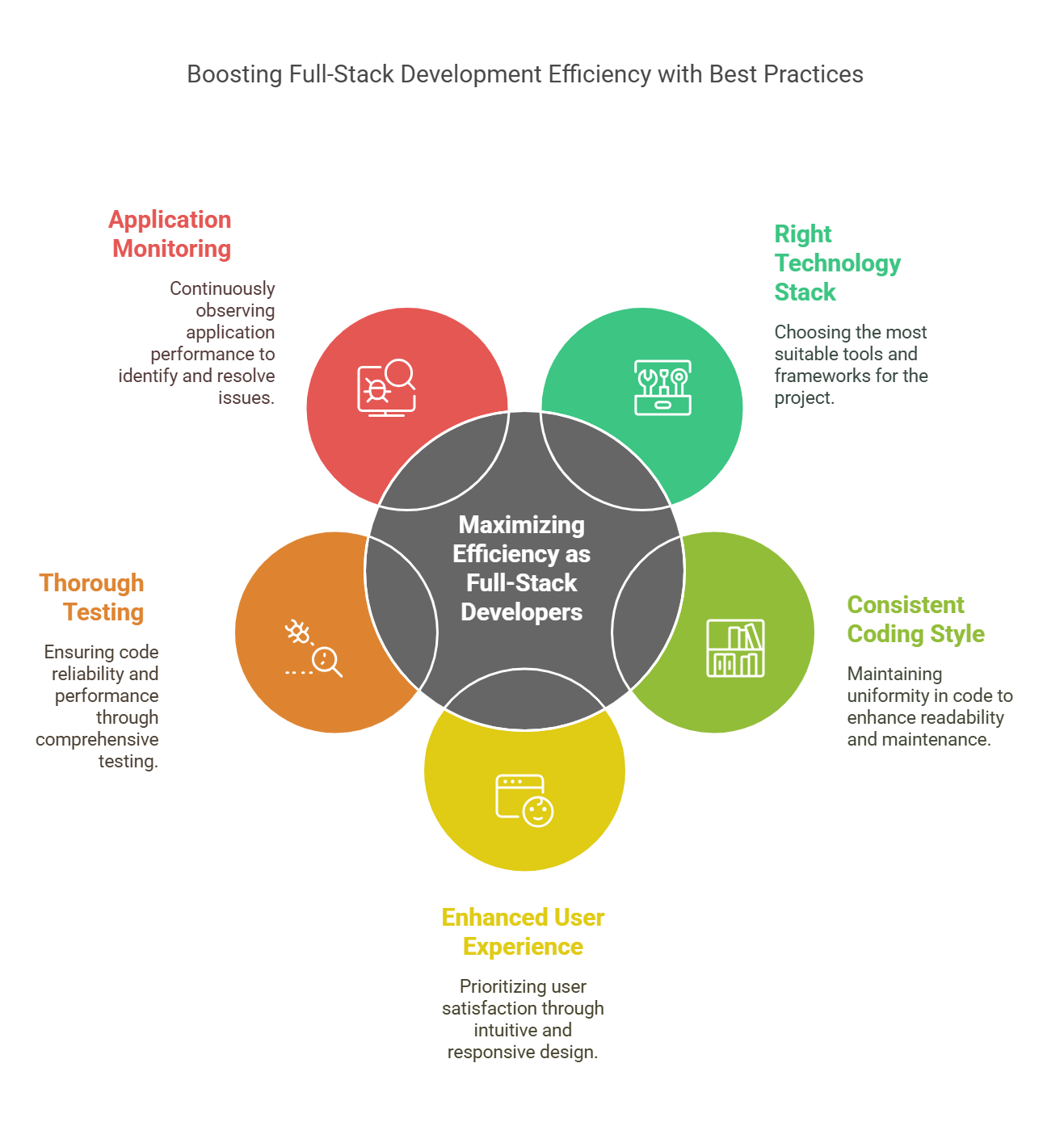
Top 5 Tips and Best Practices to Maximize Efficiency as Full-Stack Developers
As a provider of full-stack development services, you must master the art of developing an application’s front-end and back-end components and ensuring that they function effectively.
Here are some best practices that can help to maximize efficiency for full-stack development:
1. Opt for the Right Technology Stack
Selecting an appropriate technology stack is crucial for enhancing the efficiency of any full-stack development project. Your choice of the technology stack can impact all aspects of your project, right from the front-end frameworks to the back-end databases.
Simply put, it can serve as the key to successfully developing and implementing a web application. Typically, a technology stack comprises the set of technologies that you use for your development project. This includes frameworks, programming languages, databases, APIs, back-end and front-end tools, etc.
Keep in mind the following factors when choosing the technology stack to ensure optimized results:
- Analyze the project requirements. Consider complexity, scalability, team expertise, and target audience. Considering all these factors, identify the tools and technologies that can best serve your purpose.
- Go for versatile, versatile development technologies that can integrate seamlessly to ensure smooth functionality and efficient development.
- Look for tools that can streamline your development process through automation and simplification.
2. Follow a Consistent Coding Style
As a full-stack developer, you will require diverse skills to maximize your efficiency. One such skill set is a consistent coding style.
Also known as programming style, coding style refers to the rules and conventions that developers follow when writing code for any project. It includes indentation, naming conventions, spacing, formatting, comments, and more.
Follow consistent coding standards to create clean and maintainable code. Consistency ensures that your code is easier to read, understand, collaborate on, and debug. It also helps minimize confusion and ensures compatibility between various modules of code.
Overall, by using a consistent coding style, you can stay organized while developing your code and reduce cognitive overhead if the code needs modification over time.
3. Focus on Delivering an Enhanced User Experience
The success of your full-stack project depends heavily on the user experience it provides. According to a market survey, even a slow loading time causes more than 88.5% of website visitors to give up and retract. Therefore, it is imperative to consider your users when designing and developing the application or website.
Concentrate on offering your users an intuitive and user-friendly interface. Test your software with actual users and gather their feedback to enhance its efficiency and user experience.
User experience includes every aspect of the user’s interaction with your software. This involves the design, ease of accessibility, usability, and general application satisfaction.
Apart from these, you should also focus on adopting a mobile-first strategy. Start designing and developing your software considering mobile devices before scaling to larger screens. Make sure that your front end is mobile-friendly and responsive.
Conduct tests for your software using different screen sizes and devices. This will help you ensure a consistent user experience across all devices and increase its accessibility.
4. Test Your Code Thoroughly
In full-stack development, it’s essential to maintain the smooth functionality of your application or website to ensure its dependability. Testing plays a crucial part in maximizing the functionality of your software.
Thorough testing of your software enables you to identify bugs, errors, or performance snags and fix them effectively. This is essential to prevent malfunctions and vulnerabilities from impacting your project’s performance, user experience, and security.
Go for different testing approaches to eliminate bugs and errors at various layers of your website or application. Such approaches can include unit testing, functional testing, integration testing, and end-to-end testing.
Write tests first and then code to prioritize testing in the development process. This approach ensures that your code is testable. For effective testing and debugging, consider using testing frameworks and tools that can help automate the whole testing process and simplify your work.
5. Monitor Your Application
Ensuring optimal software performance is of utmost importance when following the full-stack development approach. It is one of those crucial aspects that can impact the success or failure of your software. This makes performance monitoring and optimization necessary during all stages of the development process.
Monitor your application throughout the development process to gain insight into its functioning. By tracking different parameters, you can identify performance issues and take steps to resolve or eliminate them.
Use analytics and monitoring to gather data about user behavior and leverage them to maximize efficiency and improve overall user experience.
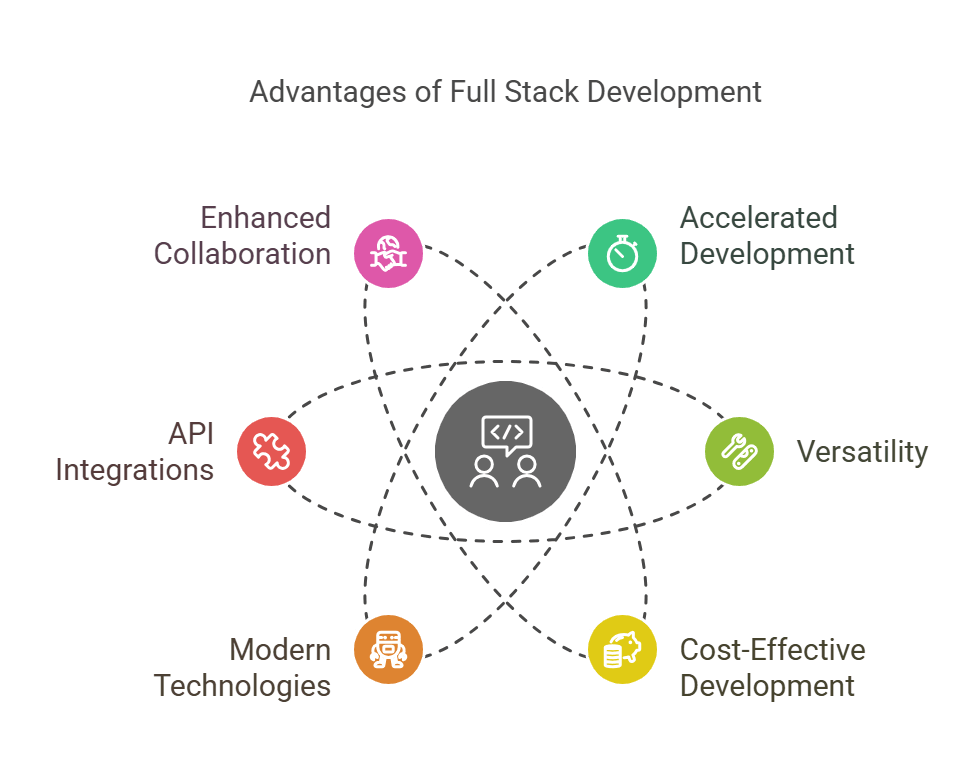
6 Benefits of Hiring a Full Stack Development Company
Now that we have understood what a full-stack development company can do for you, let’s jump into the value addition full-stack developers offer your company.
1. Accelerated Development
Full Stack Development businesses have changed the entire process of producing websites. By meeting deadlines efficiently, they have helped companies to save money and time, accelerating the pace of development.
A full-stack developer may handle several projects and eliminate the need for several developers, greatly reducing time spent and enabling quick development for the business.
It lessens the over-reliance on other specialists because a single development organization handles all operations.
2. Versatility
As of now, we are well aware that full-stack developers can handle both front-end and back-end development, eliminating the need to hire developers for different tasks. This versatility means they can handle the entire development process, from its initial conceptualization to deployment and even post-launch maintenance.
This multifaceted skill enhances the efficiency of the developers. Consequently, projects move forward faster, and deadlines are more likely to be met, enabling you to bring your product to market more swiftly.
3. Cost-Effective Development
One of the most significant reasons business organizations prefer full-stack developers is their cost efficiency. A full-stack development company will ensure that the initial stage of your mobile app development is not time-consuming.
A full-stack developer will provide solutions for all project stages. Hiring individual developers for different stages will be expensive, time-consuming, and risky in the long term. Full-stack developers will handle everything from the ground up, including site development.
4. Up to Speed with Modern Technologies
A skilled web stack developer will remain up-to-date with the latest innovations in AI development, machine learning (ML), blockchain technology, and progressive web apps. They are kept up to date with cutting-edge architecture and technology, and as a result, they have intelligent features that will eventually aid in the creation of dynamic, mobile-friendly websites.
They select complete stack technologies based on their present web stack or application stack development. The developer can create the application’s whole structure and validate fresh design concepts with the UI/UX team.
Additionally, they can support the development and upkeep of stack web applications. To handle your work more easily, you can enlist the assistance of Hurix Digital’s professionals in developing state-of-the-art software development procedures and systems.
5. API Integrations
This is one of the major benefits of hiring a full-stack developer for an organization. Application programming interfaces (API) are designed to integrate applications and services seamlessly.
APIs help full-stack developers access important data from different software components, resulting in meaningful solutions. This increases the speed of project completion without hindering quality. It also eliminates the need to develop custom code for every piece of technology used by using existing resources.
6. Enhanced Collaboration
Collaboration and teamwork are pivotal to delivering high-quality applications that meet market demand and manage the client’s expectations.
Full-stack developers’ seamless collaboration and ability to work on any aspect of the project foster a sense of ownership and accountability for the project’s success. This mentality boosts the development team members’ creativity and teamwork.
When Should You Hire Full Stack Development Services?
Now that we’ve covered how hiring a full-stack company brings value to your firm, knowing when you need their services is also imperative.
Hurix Digital provides specialists who can develop cutting-edge intelligent systems that will perfectly align with your business objectives. Following are some pointers to guide you on when to hire a full-stack development company.
- Initial Stages of an Enterprise: When your company is relatively new or smaller, the experience and foresight of full-stack programmers can do wonders for it. They can create perfect database architecture and solutions from the ground up by placing the application components wherever needed.
- Need for the Technical Role: To ensure the smooth functioning of the company and the integration of all the applications, full-stack developers can endeavor to fulfill the technical lead role with their extensive knowledge.
- Building an MVP: Building a minimum viable product (MVP) is always a good idea, as it only consists of the application’s basic features that can be tested before rolling it out in full swing. This way, the company can slowly increase the project’s value by eliminating flaws. Full-stack developers will help meet deadlines and be cost-efficient when the company intends to create an MVP.
- Limited Budget: When a company has a cost constraint, hiring a full-stack development company is the best solution to bring down the cost. The cost of hiring a front-end and back-end developer is almost 40% higher than hiring a full-stack developer who has expertise in both.
Current Scenario of Full Stack Development
In the current scenario, full-stack development has become increasingly prominent and sought after in the tech industry. Businesses are realizing the efficiency and practicality of having developers proficient in both front-end and back-end technologies.
As a result, the employment outlook for web developers will grow by 16% from 2022 to 2034, surpassing the average growth rate for all occupations.
By having developers who can work on both ends of the development spectrum, businesses can easily manage their development processes, reduce costs associated with hiring separate specialists, and have more time and money to market their apps.
It is a win-win situation for businesses, resulting in cohesive, well-rounded, and successful mobile applications.
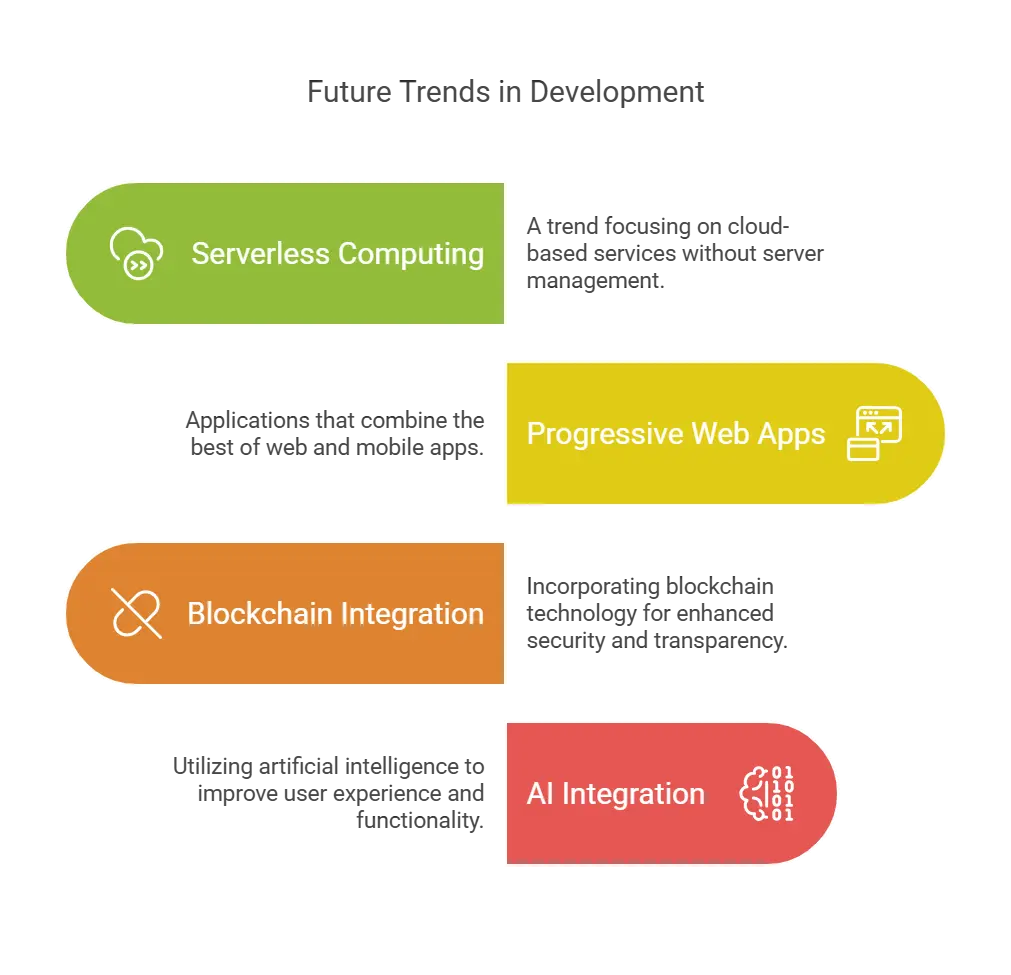
Major Future Trends in Full Stack Development
Finally, these are the major full-stack development trends you must consider integrating into your next application!
1. Serverless Computing
Serverless computing is revolutionizing full-stack app development in 2024 by abstracting away server management tasks. Unlike traditional cloud computing models, where developers must manage servers, serverless computing detaches the underlying infrastructure. It allows developers to focus solely on writing and deploying code.
In serverless architecture, applications are broken down into smaller, independent functions that are executed in response to specific events. These functions are often referred to as “serverless functions” or “lambda functions.” They are hosted and managed by cloud providers, eliminating developers’ need to worry about server maintenance.
- It enables faster development cycles as the full-stack developer only focuses on writing the code.
- It offers automatic scaling to handle varying workloads without manual intervention.
- It leads to creating highly scalable, feature-rich, and resilient apps.
2. Progressive Web Apps (PWA)
Progressive Web Apps (PWAs) are like a bridge between websites and mobile apps. In simpler terms, PWAs offer users an app-like experience directly from their web browser.
PWAs are built using web technologies like HTML, CSS, and JavaScript. However, they have features commonly found in native mobile apps, such as offline capabilities, push notifications, and access to device hardware.
- PWAs provide a seamless experience across different devices and platforms.
- They are easier and more cost-effective to develop and maintain compared to native apps.
- Lastly, they offer improved performance, faster load times, and better user engagement and retention rates.
3. Blockchain Integration
Blockchain is like a record-keeping system that stores information across a network of computers. Each ‘block’ in the chain contains a piece of data, and every block is connected to the one before and after it. This forms a secure and transparent chain of information.
Regarding future trends in full-stack development, blockchain technology is being integrated into various industries, including cryptocurrency, finance, and healthcare apps.
Another trend on the rise is the rise of decentralized applications (DApps) built on blockchain platforms like Ethereum. These apps operate without a central authority. Full-stack developers with knowledge of blockchain tech will be in high demand to create and maintain these DApps.
Benefits of Blockchain Integration
- Blockchain integration in full-stack development minimizes errors and increases operational efficiency.
- It leads to the creating of more secure, transparent, and tamper-proof apps.
- Blockchain integration leads to better data management in apps.
4. Artificial Intelligence Integration
AI, also known as Artificial Intelligence, refers to computer systems or machines that can perform tasks that typically require human intelligence. These include learning, problem-solving, and decision-making with minimal human intervention.
AI is considered an emerging trend in full-stack development because it has the potential to automate various development steps. For instance, AI-powered tools can assist full-stack developers in tasks like code generation, debugging, and testing.
Moreover, AI technology opens up new possibilities for creating innovative applications and services. For example, AI-driven chatbots can provide customer support, virtual assistants can automate routine tasks, etc.
Benefits of Artificial Intelligence Integration
- Artificial Intelligence integration automates repetitive tasks like code generation and testing.
- It leads to faster development cycles, reduced errors, and lower costs in full-stack development projects.
- Lastly, it can improve user experience by recommending personalized content.
Conclusion
As technology grows into a next-generation experience, the demand for full-stack web developers will grow faster than before. During these times, only those who hone and acquire essential skills in all facets of the web development journey will be able to thrive in the industry.
From a knack for user experience and interface design to solid foundations in front-end development and adept back-end coding, success extends to experienced testers and debugging experts with practical presentation skills.
If developing these skills is challenging, Hurix Digital can help. As e-learning experts, we can devise ideal and efficient learning modules that will get your wheels up and ready to soar as a part of the next generation of full-stack web developers.
Contact us now for more details!

Currently serving as the Vice President of Technology Delivery Operations at HurixDigital, a prominent global provider of digital content and technology solutions for publishers, corporations, and educational institutions. With over 16 years of experience spanning EdTech and various domains, I hold certification as a SCRUM Product Owner (CSPO). My expertise includes operations, finance, and adept people management skills.
